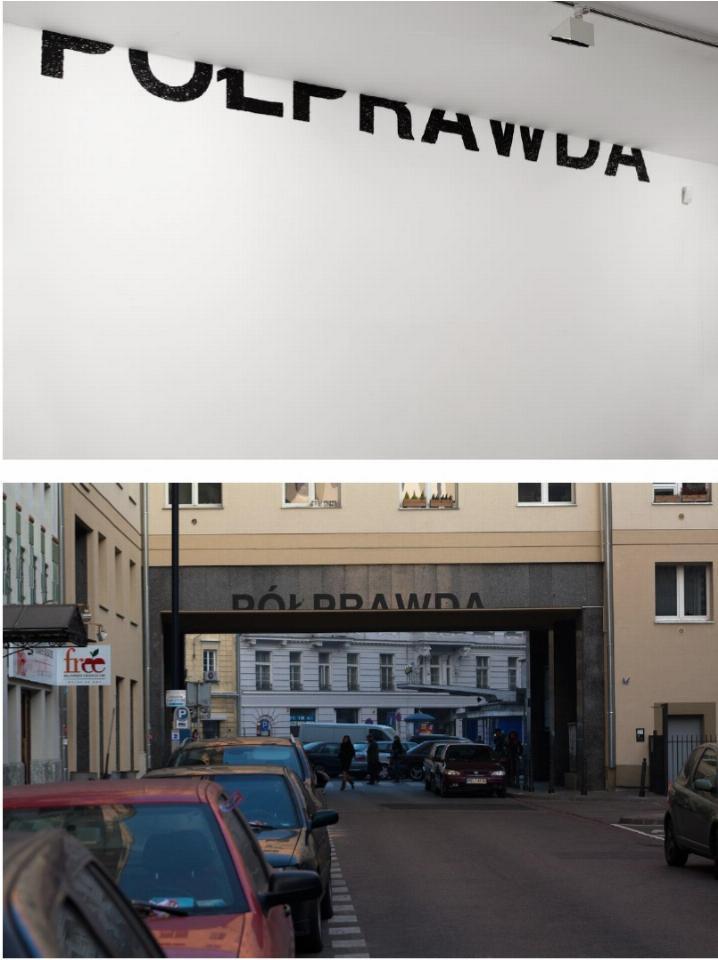Pravdolyub Ivanov
HALF-TRUTH
Pravdolyub Ivanov
Half-Truth, 1999–2017
two-part installation; indoor part: acrylic paint on cardboard, varnish, 21 × 350 cm; outdoor part: self-adhesive foil, 42 × 650 cm; edition 2 + 1 AP
Collection II of the Arsenal Gallery in Białystok. Work purchased by the Arsenal Gallery in 2019

Philosophers have been concerned with the issue of truth since Antiquity. The classical notion of truth: adaequatio intellectus et rei, created by Aristotle and developed by St. Thomas Aquinas, refers this concept to reality. However, the existence of objective reality (identified with reality as perceived by senses) has many times been put in doubt, the reason being the diversity of human cognition resulting from linguistic conditions and differences in cultural and religious systems. Thus, the current concept is the inter-subjective reality, which shaped in a given cultural circle. Reality changes with the progress of civilisation and under the influence of political events. Hence the nature of truth is also (inter-)subjective and temporal. What is true in on reality may turn out to be false in another.
In his work, Pravdolyub Ivanov refers to the conviction that objective truth does not exist. Its fundamental element is the inscription “HALF-TRUTH” divided horizontally into two parts. Following the artist’s conception, one section of the inscription is placed inside a gallery, the other outside it, in public space. The half-letters comprising the lower part of the word are written on cardboard and constitute a constant element of the work. The upper part of the word is remade for each show. In Ivanov’s perception, the linguistic image of the world is of importance; hence the word “half-truth” is always written in the vernacular language of the exhibition venue.
Ivanov plays on the form of a work and the meaning of a word, making use of the relationship between them. But to what exactly is he attempting to sensitise the spectator? Is it the fact that, in life as much as in art, we commune with only a half of the “truth” (or perhaps with a “half-truth”)? And if the inscription is put together again, what shall be the outcome: a truth or a half-truth? Ivanov displays the provocative word in two contexts, thus enquiring about the change in the way it is understood. In his view, a “half-truth” in the public sphere brings to mind political associations; a “half-truth” in a gallery prompts questions about the truth of an artwork and of the institution. While he leaves the interpretation to the spectator, he highlights the need for caution, especially in the post-modern era, filled with “fake news” and unverifiable information. In addition, he poses an ironic question regarding the role of the artist, entangling his own person, Pravdolyub, which means “one who loves the truth”, in the semantics of his work.
Izabela Kopania
translated from Polish by Klaudyna Michałowicz
Has art preserved its capacity for remaining ahead of its times, as it used to remain in heroic modernist years, era of the avant-garde and of investing all hope in the future? In general, it does not have such gift – yet there are exceptions to the rule, according to which reality tends to leave art ever further behind, artists focusing on managing today’s cognitive crisis rather than on designing the future; discerning actual developments around us is becoming increasingly difficult in the massive deluge of data. Related exceptions include an installation set up by Ivanov originally in 1999, then repeated a number of times in a variety of contexts, among others as part of his first exhibition in Warsaw’s Le Guern34 Gallery. The work was named Half–Truth (Półprawda), and depicted the title concept: the word “Half-Truth” cut in half along the horizontal axis. Ivanov’s realisations are frequently developed on the verge of language, in fissures between the concept and its image. In case of the Half-Truth installation, the fissure was particularly large. The lower part of the word was observable in the exhibit room. Where was the other “half of the truth”? In order to locate it, one had to exit the gallery and walk nearby streets – the upper part of the concept was arranged in public space, on the façade of a local tenement house. One half of truth is concealed in the world of art, the other in reality, one could well say – and such thought might reflect a crucial aspect of Ivanov’s oeuvre; in his work, Ivanov seeks a “third way”, meandering between the traditional artefact of art and an actual object gleaned from real life. Yet what do we obtain when identifying and matching the two halves of the “half-truth” notion? The entire truth? The entire half-truth? Or should “half-lie” be recognised as the other half of “half-truth”?
Ivanov kept asking these questions for many years before the notion of “post-truth” became common to the public discourse, defining the epistemological condition of “late contemporariness”. It is no coincidence that the artist’s name means “truth lover”. Notably, however, Ivanov was not the only one to apply the figure (though not necessarily the concept) of post-truth long before its discovery by politicians. Artists and politicians are bipolar in putting the discovery to use. While in politics, post-truth has become a synonym of manipulation, in art it has traditionally been a tool of resistance and criticism in the objectivised discourse of broadly perceived art. Yet all intentions aside, post-conceptualism – the trend Ivanov’s oeuvre may be recognised as part of – is something of a strategy in developing half-truths: objects which are neither “pure” reality nor its “representation”, but a set of “alternative facts”.
An excerpt from the essay ‘(Easier) Life is (Still) Somewhere Else’ by Stach Szabłowski, published in the exhibition catalogue Pravdoliub Ivanov. Innym żyje się jakoś łatwiej / The Life of Others is Somehow Easier, Galeria Arsenał, Białystok 2019

PLAN YOUR VISIT
Opening times:
Thuesday – Sunday
10:00-18:00
Last admission
to exhibition is at:
17.30